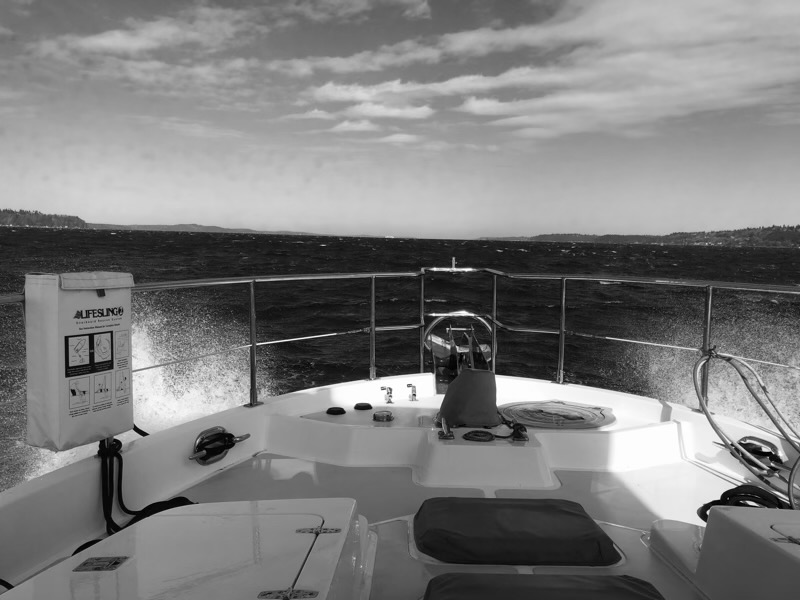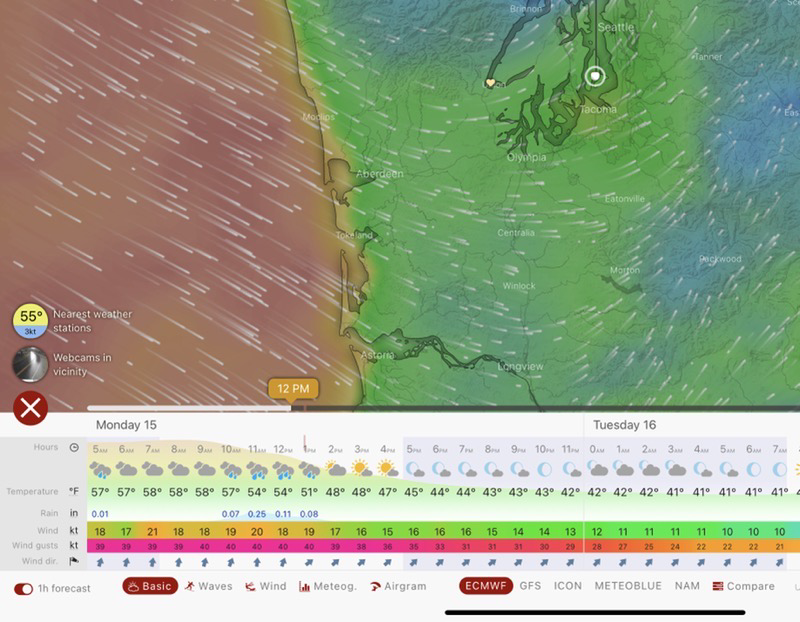We’re in the middle of a wet, windy month here in the Pacific Northwest. A weather phenomenon known as a “bomb cyclone” brought sustained winds of 30 knots and gusts up to 50 knots earlier this month. Since then, successive weather systems, aptly called atmospheric rivers, have pummeled Puget Sound, bringing rain and high winds almost every day. Today is no exception: a new storm has knocked out power to our entire island, so we’ve added the steady hum of our noisy generator to the whistling of 40-knot winds and the percussion of rain strafing the windows.
It is said a mariner’s plans are written in sand at low tide. We’ve already canceled two trips because of deteriorating weather this month. A friend of ours, who rode out the cyclone on his boat up in the San Juan Islands, teased me when I mentioned our change of plans.
“You’re in a Nordhavn! That boat can handle anything,” he chuckled.
He’s right. Nordhavn trawlers are built for heavy weather, with many open ocean crossings under their collective keels. I didn’t cancel our plans because of any limitations of the boat. It’s crew discomfort I fret about.
I recall a conversation about this with the skipper of Epoch, a Nordhavn 47. Scott had graciously welcomed us aboard, back when we were first looking at trawlers, and we enjoyed our first glimpse of one of these beautiful yachts. He shared his plans of taking Epoch down the coast to Mexico and beyond (he and Abby are now cruising the Eastern Seaboard aboard Orenda, a Nordhavn 55). We commended Scott on his selection of such a seaworthy vessel, capable of handling just about any sea conditions.
“I hope to never find myself in the really bad stuff,” he said. “If I do, it means I screwed up somewhere in my planning.”
I like Scott’s way of thinking. It’s nice to have the rough weather capabilities of an ocean-going trawler — just in case — along the lines of buying life insurance. I hope not to require that anytime soon either.
Steady As She Goes
While I do my best to avoid heavy weather, I find I enjoy myself when we’re in the thick of it. I like the feeling of a heavy sea, the sounds of various things shifting in the lurch of a wave, stomach muscles tensing from the pitching fore and aft, the fountains of spray and green water that flood the foredeck ahead of the Portuguese Bridge. I feel especially fond of our little ship as she slides through the whipped-up waves and wind, keeping us safe and warm inside the pilothouse.

I’ve been caught with too much sail up during squalls in our sailboats, and the feeling then was different: a mix of adrenalin-fueled fear and exultation, my feet braced against the coaming as the boat heeled with the gusts to an astonishing angle and the rig groaned under the pressure of the wind. Sailing seven miles an hour in a gale feels like a high speed car chase on the freeway.
Our watery world on the trawler is mostly insulated from the extremes of wind and waves. Without gauges to inform me, it’s hard to tell if the wind is blowing fifteen knots or thirty. Yet, docking this trawler in high winds does bring me squarely into the present moment. I move up to the flybridge for these occasions for better visibility while Lisa takes her position in the cockpit at the far stern of the boat to handle dock lines. We talk through our Eartec headsets, but I feel a world apart from her up here. I’m exposed to the wind and weather, which shakes me from any lethargy I might have felt in the cozy confines of the pilothouse. I scan the basic instruments on the flybridge dash: an electronic chart, water depth, boat speed, and wind speed, but from this elevated perch, I have all the data I need swirling around me: the height and shape of the waves, the boat’s progress through the water toward the approaching marina, the feel of the wind on my cheek.
Any uncertainty I harbored in trip planning or assessing forecasts vanishes. For 99% of my time aboard the trawler, I am as skeptical and doubting as Mr. Spock, always scanning for trouble. But put me at the helm during an approach to a windy dock, and I’m suddenly a brash Captain Kirk piloting the Enterprise through an uncharted nebula. In a life that’s usually ordered and controlled, docking in high wind brings a raw wildness, like driving down a mountain road in snow and ice with shoddy brakes. Anything can happen, often with onlookers. “Steady as she goes, Mr. Sulu,” I sometimes mutter as we close with the solidity of the windswept dock. Lisa laughs when she hears this on the headset, but it’s a nervous laugh.
Luckily, in our three years of trawler ownership, we’ve managed to avoid the docking mishaps my worrisome imagination had envisioned. Indiscretion’s bow and stern thrusters have saved the day a few times. Still, I’d much rather avoid the whole drama if at all possible. Hence our keen interest in weather forecasts.
Windy, the Great Sage of Wind Forecasts
I used to roll my eyes at the comically unreliable weather forecasts of the nightly news. That sure has changed. An explosion of meteorological observation data fed into sophisticated computer models has vastly improved the accuracy of weather predictions, making even long-range forecasts pretty insightful. We rely on the weather app Windy for our forecasting and trip planning and pay extra for its premium features for the more frequent updates and by-the-hour forecast granularity. It’s been well worth it.
As an example, Windy predicted 42 knots of wind would greet us on our planned arrival at a Nordhavn Rendezvous in Poulsbo last May. Yet, the event was still ten days away.
“How can they possibly predict anything that far in advance?” I scoffed when Lisa pointed out the forecast. “Let’s watch it. I’m sure it will change.”
Three days later, with the rendezvous now a week away, a wind advisory remained in effect: 42-44 knot gusts at the time we planned to arrive. The Poulsbo Windy forecast became our morning topic of conversation over coffee.
Windy was still predicting 40+ knot winds as we got within four days of the event, which was enough prognostication for me. I called the marina and changed our reservation to get there a day early to be safe.
We arrived at the lovely Poulsbo Marina in dead calm. We were the first of more than forty Nordhavn trawlers to attend this biggest-ever gathering. Backing a 46-foot trawler into a 30-foot slip can be interesting, so I was glad to perform this docking without dozens of more experienced trawler captains commenting on my technique from the quay.
We woke the next morning to a beautiful sunny day. Zero wind. Could Windy have got it wrong, we wondered?
Not a breath of wind stirred at 10 am. At noon, a little wind began to ripple the fairways of the marina. But by 2 pm, gale force winds out of the south arrived exactly as Windy had predicted. Indiscretion groaned at her dock lines in 40-knot gusts as we hustled from dock to dock, helping arriving boats get safely tied up. Landing a 100,000 pound trawler gives you a new perspective on the sheer weight of these beasts. You can shove all you want, but no amount of muscle is going to fend off a full displacement vessel pinned to a dock in a blow. A few boats in the anchorage drug their anchors that afternoon as gale-force winds tore through Liberty Bay. Only the heroics of the marina crew in a skiff prevented the collision of a dragging sailboat with a very expensive Nordhavn trawler on an end-tie of the dock.
It still astonishes me that a weather app predicted this gale a full ten days ahead of time. So much so that we now think of Windy as an essential member of the crew. We’ve encountered a few false positives when the high predicted gusts failed to materialize, but I can’t recall a time when we had high winds that Windy didn’t anticipate. I’m sure there are other excellent weather forecasting apps (we have friends who swear by PredictWind), and an iPhone app is no replacement for an experienced weather router for ocean passages, but I won’t sail anywhere these days without checking Windy first.
I Think I Got Cabin Fever
I’ve lived in the Pacific Northwest for most of my life, and yet I can’t remember a longer stretch of wet, stormy weather. We manage to get out and walk the dogs along our island trails during breaks in the rain, but it’s been a full month since we’ve gone anywhere by boat — our longest time on land in a long, long while. While we’ve remained in port, boating friends of ours have continued to ply these windswept waters without shipwreck or other calamity. Perhaps they carry on in blissful ignorance of the looming wind and weather. More likely, they know and don’t care. Ships weren’t made for safe harbors after all.
One of the benefits that comes with retirement is a greater sense of patience. We don’t have the same constraints that would otherwise force us into sailing in inclement weather because of rigid schedules, the bane of every mariner. Taking the dogs ashore three times a day in a rain-and-wave-soaked tender makes us both pause and reconsider. Do we really want to go out in this?
But maybe, just maybe, our fortunes are about to change. This morning’s forecast calls for two more days of high winds with a chance that things might settle down after that. The mere prospect of blue skies and calm seas lifts my spirit. With a decent weather window, we could head for the southern reaches of Puget Sound, or turn the bow north to enjoy the San Juan Islands in the off season. Feeling the thrum of that big Lugger engine beneath me and the gentle roll of a boat underway is the perfect antidote for this claustrophobic stretch of land-based life.
As Aristotle once counseled, “patience is bitter, but its fruit is sweet.” Let that please be true!

